| Specialized Classrooms |
Classroom Photos |
Purpose of Setup |
| Kindergarten Teaching Simulation Classroom (C601) |
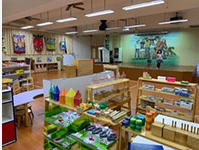 |
| 1. |
Equip students with practical skills in early childhood education and care. |
| 2. |
Develop students' ability to design learning environments for young children. |
| 3. |
Guide students in the use of educational toys. |
| 4. |
Assist students with project development to inspire creativity. |
| 5. |
Provide a rehearsal stage for drama presentations and graduation exhibitions. |
| ◎ |
Facilities are used for learning environment design, early childhood teaching, and practice. |
|
| Sensory Integration and Movement Classroom (C802) |
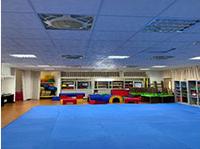 |
| 1. |
Enhance students' understanding of motor skill development in young children. |
| 2. |
Offer opportunities for designing and practicing sensory integration and movement activities. |
| 3. |
Foster creativity in planning sensory integration and movement activities. |
| 4. |
Familiarize students with the use of sensory integration and movement teaching aids. |
| ◎ |
Facilities are used for hands-on practice with specialized teaching aids, observing and assessing children's development, and developing skills for special needs education and care. |
|
| Creative Arts and Crafts Classroom (C608) |
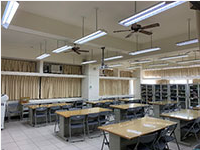 |
| 1. |
Improve students' understanding and practical application of creative education theories for children. |
| 2. |
Promote understanding of the purpose and spirit of creative educational tools. |
| 3. |
Provide opportunities for operating and producing creative educational tools for children. |
| 4. |
Enhance students' experience in planning and executing creative teaching practices. |
| ◎ |
Facilities are used for multimedia teaching, fostering creativity, and arts and crafts courses. |
|
| Child Health and Nutrition Classroom (C602) |
 |
| 1. |
Understand regulations related to child care certification. |
| 2. |
Gain familiarity and practical skills for child care certification. |
| 3. |
Prepare for participation in national child care certification. |
| 4. |
Understand the nutritional needs and dietary hygiene of infants and toddlers. |
| 5. |
Learn the principles and applications of food substitution. |
| 6. |
Plan and prepare healthy meals for infants and toddlers. |
| 7. |
Design and execute nutritious menus for childcare institutions. |
| ◎ |
Facilities are used for teaching infant bathing, first aid, health care techniques, and preparing infant foods and nutrition. |
|
| Montessori Classroom (C704) |
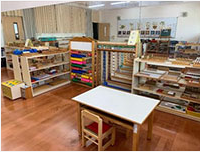 |
| 1. |
Enhance students' understanding and practical application of Montessori educational theories. |
| 2. |
Promote understanding of the purpose and spirit of Montessori materials. |
| 3. |
Provide opportunities to operate and practice using Montessori materials. |
| 4. |
Develop students' skills in planning and arranging Montessori classroom environments. |
| ◎ |
Facilities are used for Montessori-related courses, practical training, and displaying award-winning entries from the National Creative Environmental Teaching Aids Competition. |
|
| After-School Care Simulation Classroom (C610) |
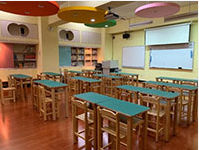 |
| 1. |
Equip students with a basic understanding of after-school care concepts. |
| 2. |
Develop students' ability to plan after-school care programs. |
| 3. |
Guide students in practicing after-school care techniques. |
| ◎ |
Facilities are used for professional after-school care courses. |
|
| Childcare Skills Certification Classroom (C401) |
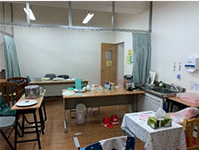 |
| 1. |
Understand regulations related to childcare certification. |
| 2. |
Gain familiarity with the designated subjects of childcare skills certification. |
| 3. |
Enhance practical skills in infant care and successfully pass national childcare certification. |
| ◎ |
Facilities serve as a venue for health and safety training, childcare techniques, and onsite certification tests. |
|
| Auditorium (C801) |
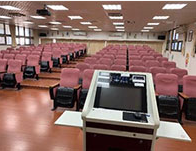 |
| 1. |
Cultivate students' ability to express ideas and opinions through oral, written, and other forms. |
| 2. |
Encourage students to create and perform in various formats. |
| 3. |
Guide students in understanding roles and responsibilities in a group, promoting independent thinking and problem-solving. |
| 4. |
Host academic seminars, teacher-student meetings, and project presentations. |
| ◎ |
Facilities are used for seminars, teacher-student discussions, and special topic presentations. |
|
| Audio-Visual Classroom (C611) |
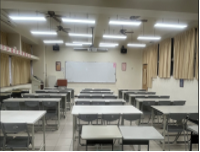 |
| 1. |
Present teaching materials through audio-visual methods to enhance diversified learning. |
| 2. |
Train students to use multimedia tools to design teaching content. |
| 3. |
Cultivate students' ability to create and arrange activities for children. |
| ◎ |
Facilities are used for professional courses such as child observation, children's theater, and learning assessments. |
|